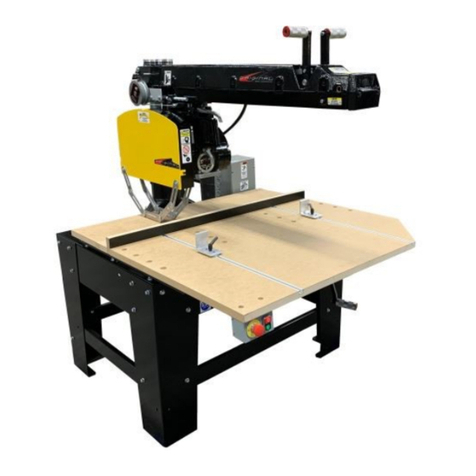
Unpacking
The box included in our shipment contains the legs, hardware and wrenches. Please use the following procedure to remove
the box: Remove the elevating handle from the hardware bag fastened to the carton top. Install handle on shaft located at
the lower right side of saw frame. Release the column clamp, elevate the arm and remove carton.
Attaching the Table Legs
The machine can be lifted with a fork lift under the steel saw frame. A sling or chain hoist ma be used under the arm ONLY if
placed at the rear of the arm near the column with the arm clamp handle and the base clamp handle tightened down.
Attach the legs using the 3/8” hex head cap screws, lock washers and nuts provided in the hardware bag.
Tighten cap screws securel after the machine has been lowered onto its legs. When the saw has been placed in its perma-
nent location shim the legs where necessar to provide a solid foundation. This is important to maintaining an accurate cut.
In order to prevent the forward movement of the carriage when the operator releases his grip, it is recommended the front
legs be shimmed.
Important
Loosen the 2 cable clamps (1 inside of arm, 1 at right rear of arm) and adjust the cables so rollerhead is free to travel the
total length of the arm with the motor pivoted in the roller head so the blade is on the right hand side. Also, check to ensure
there is enough slack in the cables between the rear of the arm and the starter enclosure so the arm can be swung to the
right a full 900 while the arm is elevated to its highest position.
Electrical Hookup
Recommended Copper Wire Sizes (A.W.G.)
To obtain maximum efficienc from our saw motor, the feeder wire from the power source to the machine should compl
with the table below.
1 Phase 3 Phase
Motor Horsepower 200-240 V 200-240 V 440-480 V 550-600 V
5 6 6 — —
7.5 — 4 6 8
NOTE: This table is based on 60-100’ distances from power suppl . Less than 60’ ma use one even size smaller (high num-
ber = smaller size); 100-160’ use one even size larger, over 160’ use two even sizes larger.
Connecting Electrical Current See pg 30 for full description
The motor is properl connected to the variable frequenc drive at the factor for operation on the electrical voltage specified
on the tag attached to the electrical enclosure. Make sure incoming voltage from our power suppl conforms to the voltage
specified on the tag.
Loosen the 2 screws that tighten the door on the drive enclosure, swing open the door. Insert power suppl cable through the
dust proof fitting and connect wires to R/L1, R/L2 and R/L3, and ground to the ground screw. Wiring must conform to the
National Electrical Code and an applicable local codes.
Check Arbor Rotation (3 Phase Only)
Check arbor rotation with arbor nut and arbor collars removed. Open line disconnect to the saw to remove arbor nut and
collars, close the line disconnect and start saw. The rotation of the arbor must be clockwise as indicated on the arrow on the
nameplate. If the rotation is counterclockwise, the outgoing power wires to the motor much be switched around, to do so
simpl interchange an 2 of the outgoing power wires, V/T1, V/T2, V/T3 and this will reverse rotation.
Changing Voltage
(Dual Voltage otors Only)
1. The motors on the Original Super Dut Series are dual voltage but the are powered using a Variable Frequenc Drive
that is voltage sensitive and cannot be field changes, please contact technical support for information 800/733-4063.



































